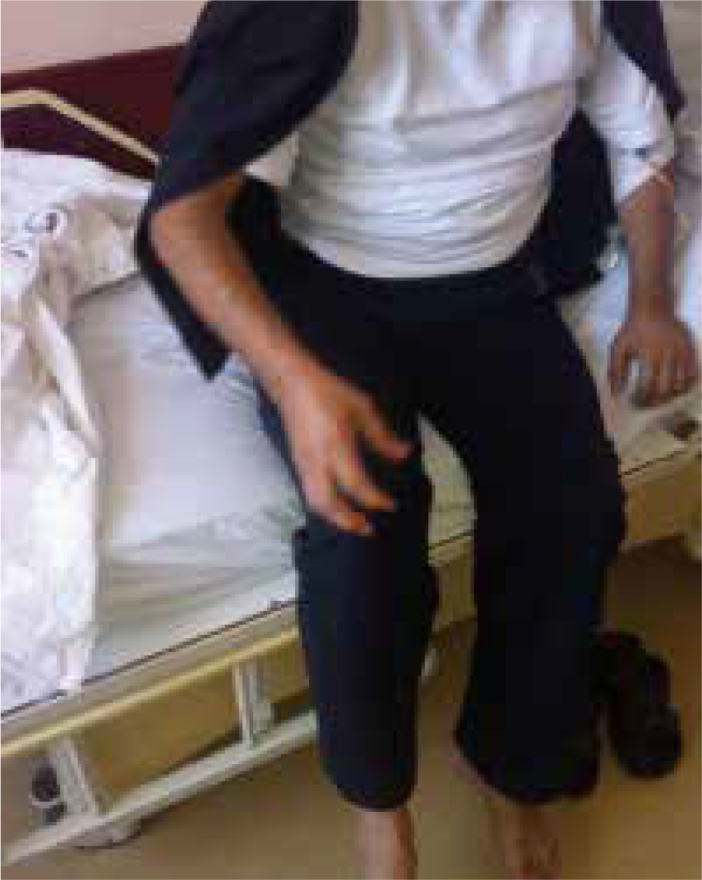Dear Editor,
Dystonia is an involuntary movement, mostly due to repetitive, long lasting twisting muscle contractions, causing abnormal postural changes in body, or parts of body (1). Dystonia can be differently named as continual or paroxysmal depending on contraction duration, or focal, segmental, multi-focal, generalized or hemi-dystonic, according to the affected body location (2). Idiopathic paroxysmal dystonia can be subcategorized as kinesigenic, non-kinesigenic, hypnogenic, and the exerciseinduced forms (3).
Here, we report the case of a 40-year-old male with episodes of paroxysmal non-kinesigenic dystonia (PNKD) as the first manifestation of multiple sclerosis (MS), secondary to an acute demyelinating lesion in the left posterior limb of the internal capsule detected by magnetic resonance imaging (MRI). PNKD was localized on the right arm and limb region, with symptoms started in the previous week (Figure 1). The episodes of dystonia lasted 5–30 seconds and repeated 4–7 times a day. He had no family history of any movement or other neurological disorders. He was not using anti-emetics, antipsychotics or any other medications. Except for PNKD, the physical and neurological examinations were normal. Laboratory tests, including blood chemistry and both rheumatologic and immunologic screening tests, were normal. MRI of the brain revealed multiple periventricular hyperintensities on T2-weighted images. There was also an axial-coronal T1-weighted image with contrast showing enhancement of a nodular hyperintense active MS plaque in the left posterior limb of the internal capsule (Figure 2). No lesions were observed in the basal ganglia or thalamus. The patient was diagnosed as having MS according to the new McDonald’s criteria (2010 revision). These episodes disappeared with high-dose methylprednisolone (1 g/day for 5 days) treatment.
Figure 1.

Paroxysmal non-kinesigenic dystonia was localized on right arm and limb region
Figure 2.

Axial T2-weighted and axial-coronal T1-weighted image with contrast showing enhancement of a nodular hyperintense active MS plaque in the left posterior limb of internal capsule
Paroxysmal dystonia is rarely observed in patients with MS and its pathogenesis remains unknown. Several mechanisms have been suggested by Transcranial Magnetic Stimulation studies for dystonia, including transversely spreading ephactic activation originating the axon within the partially demyelinated lesion at any level of motor fiber tracts, and axonal irritability secondary to releasing of inflammatory mediators (4,5).
Acquired paroxysmal dystonia is frequently seen in the lesions involving the basal ganglia, extrapyramidal tract system, or thalamus. Other than typical localizations, sporadic cases exist involving demyelinated plaques in the cervical spinal cord, midbrain, medulla, internal capsule, and cerebral peduncle, even cases of MS not explainable by anatomical evidence have been reported (6,7).
This paper suggests that in patients with acute paroxysmal dystonia, neuroimaging is often useful in excluding structural lesions. This case, therefore, illustrates the need to consider MS in the differential diagnosis of all paroxysmal dystonias, particularly in those with abrupt onset, even in the absence of any other neurological abnormality. Nevertheless, explaining the underlying pathophysiological mechanism is not trivial for the limited dystonia in the right arm and leg of our case.
References
- 1.Tarsy D, Simon DK. Dystonia. NEJM. 2006;355:818–827. doi: 10.1056/NEJMra055549. [DOI] [PubMed] [Google Scholar]
- 2.Mehanna R, Jankovic J. Movement disorders in multiple sclerosis and other demyelinating diseases. J Neurol Sci. 2013;328:1–8. doi: 10.1016/j.jns.2013.02.007. [DOI] [PubMed] [Google Scholar]
- 3.Dressler D, Benecke R. Diagnosis and management of acute movement disorders. J Neurol. 2005;252:1299–1306. doi: 10.1007/s00415-005-0006-x. [DOI] [PubMed] [Google Scholar]
- 4.Usmani N, Bedi G, Lam BL, Sheremata WA. Association between paroxysmal tonic spasms and neuromyelitis optica. Arch Neurol. 2012;69:121–124. doi: 10.1001/archneurol.2011.832. [DOI] [PubMed] [Google Scholar]
- 5.Trompetto C, Avanzino L, Bove M, Buccolieri A, Uccelli A, Abbruzzese G. Investigation of paroxysmal dystonia in a patient with multiple sclerosis: a transcranial magnetic stimulation study. Clin Neurophysiol. 2008;119:63–70. doi: 10.1016/j.clinph.2007.09.123. [DOI] [PubMed] [Google Scholar]
- 6.Hsieh PC, Chen SM, Guo YH, Kuan TS, Yen WJ, Chang WC, Lin YC. Effect of acetazolamide for long-lasting paroxysmal dystonia in a patient with multiple sclerosis: a case report and review of literature. Neuropsychiatr Dis Treat. 2013;9:445–448. doi: 10.2147/NDT.S43688. [DOI] [PMC free article] [PubMed] [Google Scholar]
- 7.Rajabally YA, Farrell D, Messios N. Oro-mandibular dystonia in a case of multiple sclerosis with capsular plaque. Eur Neurol. 2003;49:190–191. doi: 10.1159/000069084. [DOI] [PubMed] [Google Scholar]


